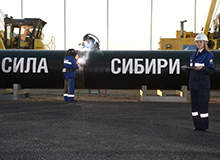

The Power of Siberia project is a unified gas transmission system (GTS) involving the development of a 4,000km-long gas pipeline to transfer natural gas from Yakutia and Irkutsk gas production centres in Eastern Russia to the Far East and China. The project is being developed by Russia’s state-owned Gazprom, the world’s biggest natural gas producer.
Construction of The Power of Siberia GTS was launched with the welding of the first joint for the pipeline in September 2014. The first section of the pipeline connecting the gas production centre in Yakutia with the city of Blagoveshchensk on the Russian-Chinese border is expected to be operational in 2018.
Power of Siberia gas pipeline project details
The Power of Siberia gas pipeline will deliver gas from Irkutsk (Kovyktinskoye field) and Yakutia (Chayandinskoye field) gas production centres to Vladivostok via Khabarovsk. Kovyktinskoye and Chayandinskoye are Eastern Russia’s two major gas fields holding 1.2 trillion and 1.5 trillion cubic metres of gas reserves respectively.
The ESPO (Eastern Siberia Pacific Ocean) oil pipeline will be a 4,700km (2,900 miles) pipeline system. Once constructed, it will export crude oil from Russia to the Asian Pacific markets of Japan, China and Korea.
The pipeline will pass through five regions in Russia, including the Irkutsk Region, the Republic of Sakha (Yakutia Region), the Amur Region, the Jewish Autonomous Region, and the Khabarovsk Territory.
The system will comprise two gas trunk lines – the 3,200km-long Yakutia – Khabarovsk – Vladivostok gas trunk line and the 800km-long pipeline connecting Kovyktinskoye gas field in the Irkutsk Region with the gas production centre in Yakutia.
The GTS, comprised of 1.4m diameter pipeline and designed to operate at 100 Atmospheres Absolute (Ata) working pressure, will be capable of transporting up to 61 billion cubic metres (bcm) of natural gas per annum.
Gazprom signed a $400bn contract with China National Petroleum (CNPC) in May 2014 to supply 38 billion cubic metres of gas annually for the next 30 years. Approximately $55bn of the total contract value will be invested in the construction of new production and transmission facilities.
Power of Siberia GTS construction and route details
The first phase of the project includes the construction of a 2,200km pipeline between the Chayandinskoye field in Yakutia and the city of Blagoveshchensk on the Russian-Chinese border. The next phase construction will involve an 800km pipeline connecting Kovyktinskoye field in the Irkutsk Region to the integrated gas production centre near Chayandinskoye field.
A 1,000km pipeline from the town of Svobodny in the Amur Region to the city of Khabarovsk will comprise the final section of the gas transmission line.
The Power of Siberia pipeline will connect with the Sakhalin-Khabarovsk-Vladivostok GTS at the city of Khabarovsk.
Gas production from the Chayandinskoye field will start in the end of 2018. Gazprom will also construct a gas processing plant near Svobodny in the Amur Region to extract components such as helium and ethane from natural gas. The first train of the Amur gas processing plant is expected to be operational in 2018.
The Yakutia – Khabarovsk – Vladivostok gas trunk line will be laid parallel to the Eastern Siberia – Pacific Ocean oil pipeline to reduce the infrastructure and power supply costs.
The first batch of pipes comprising 260 pipes each with 1.4m diameter, 21.7mm wall thickness, and weighing 2.4000t in total were delivered for the Chayandinskoye – Lensk section of the pipeline in August 2014. The pipes were delivered to the Irkutsk Region by rail and to the Lensk region by barge.
Technologies used
Gazprom is using membrane helium separation technology at the Chayandinskoye field for the first time in Russia. The technology is used to separate helium component on the spot and only the required amount of helium can be sent into the pipeline.
The pipeline project uses efficient design concepts, power saving technologies and advanced line pipe monitoring systems due to the complex geological and climatic conditions along its route. Longitudinally welded pipes made of cold resistant steel K60 with external anti-corrosion and smooth internal coating are being laid for this reason. High strength pipes will be used in the areas prone to intense seismic activity and tectonic faults.
Contractors involved with the Eastern Russia pipeline project
Gazprom Transgaz Tomsk, a wholly-owned subsidiary of Gazprom, is responsible for the construction of The Power of Siberia pipeline. VNIPIgazdobycha is engaged as the general design contractor for the project.


